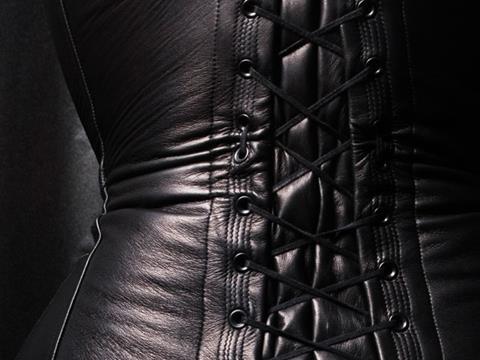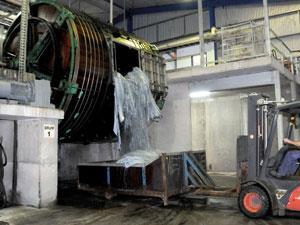Despite a history going back thousands of years, the leather tanning industry is still using chemistry to improve its processes. James Mitchell Crow examines the latest environmentally friendly advances
Despite a history going back thousands of years, the leather tanning industry is still using chemistry to improve its processes. James Mitchell Crow examines the latest environmentally friendly advances

Since their invention in the 16th century, leather corsets had been stiffened with bone inserts. Toward the end of the 19th century, in the true spirit of the industrial revolution, the bone began to be replaced by strips of iron. Unfortunately, these metal stays were not stainless steel and, in the warmth and humidity generated by the wearer’s body, they would start to turn rusty. And the corsets started to turn undesired shades of blue or black as they absorbed iron.
At the time, leather was tanned with plant extracts rich in tannins, says Tony Covington, a leather chemist at the University of Northampton, UK. Mixed with iron, however, these polyphenolic natural products have another use – they form inks, hence the colourful corsets. And so the leather manufacturers began to experiment. Their discovery – that leather can be tanned with chromium(iii) salts rather than plant extracts – not only ended the corset affair, it revolutionised the leather industry.
Quite how important discoloured corsets really were to the shift in tanning technology is debated, says Covington, who adds that many argue that chrome tanning was first mentioned around the middle of the 19th century. What is clear is that, around the turn of the 20th century, the 5000-year-old process of ‘vegetable tanning’ was all but swept away within a decade or two, such were the advantages of the chromium-based technique. Just over a century later, could the same happen again with a new generation of tanning reagents?
Nice tan
Although leather-making is a multi-step process, tanning is the key operation that turns animal hides from a material very susceptible to rotting into something robust and microbe-resistant. From the chemist’s point of view, leather is essentially collagen, a structural protein that gives skin its strength and elasticity. In the skin, individual strands of this natural polymer pack together into triple-helices largely held together by hydrogen bonds. These triple helix structures aggregate to form fibrils, which are supported by a surrounding network of water molecules.
At heart, tanning is the process of locking the collagen fibril structure in place to prevent it from collapsing as water is gradually removed from the pelts after tanning. For millennia, tanning was painstakingly achieved by packing the area around the collagen full of plant polyphenols. Vegetable-tanned leather typically incorporates up to 30% polyphenols by pelt weight, a figure that takes months to achieve as the skins are repeatedly soaked in vats of tannin solution.
Chrome tanning, in contrast, takes just hours to complete. Much less material is incorporated into the hide than for vegetable tanning, says Covington. ‘About 2.5% chromium gives you more stability, in terms of hydrothermal resistance, than veg tanning.’
The stabilisation effect of a tanning process is measured by the hydrothermal stability of the end product – that is, the temperature at which the collagen protein network begins to denature and the hide to shrink. Unmodified collagen denatures at 65°C, which can be raised to around 80°C by vegetable tanning. Chrome tanning, in contrast, pushes the denaturation temperature up to around 110°C.
The other main advantage of chrome-tanned leather is that, thanks to the fact that it is not packed with dark polyphenols, it can be dyed brilliant colours. ‘The change from vegetable to chrome tanning came when there was this revolution in dyestuff chemistry after the introduction of mauvine. If you try to put those modern dyes on veg leather, you get what is referred to as a “sad” colour, whereas with the chrome leather you get bright, vivid shades.’

Covington argues that there is a two-step stabilisation mechanism at play. Any additive that sticks to the collagen to interfere with the shrinking process will give an initial stabilisation – which explains why both vegetable tanning and chromium fluoride tanning give about the same stabilisation effect. But if you can then ‘lock’ those additive molecules together – as occurs with the sulfate anion, which is a powerful hydrogen-bonding agent – the stabilisation effect is markedly improved, he says. ‘You convert an individual effect into a concerted interaction with the collagen, and that makes the breakdown process much more difficult.’
The concept has already caught on, he adds. ‘I know of at least two international supply houses that are using the idea to inform their development of the next generation of tanning chemicals.’
Step by step

Although the Australian leather industry has faced some fairly unique challenges, Money and her CSIRO colleagues’ contributions to leather production are now being used around the globe. For example, the traditional first step in the process is to salt the fresh hides to protect them from decay as they are transferred from abattoir to tannery. Vast quantities of salt are involved, which ultimately ends up in effluent streams. A tannery will typically receive 2,000 salted hides per day, Money says, which will have required about 15 tonnes of salt for the preservation process. About a third of this salt will remain at the source as brine waste. The remaining salt, absorbed by the hides, is removed during processing, adding 10 tonnes per day of salt to the tannery’s wastewater stream. In Australia, where fresh water can be scarce, this salt has soured an otherwise potentially valuable source of irrigation water.3
Money and her colleagues at CSIRO showed that salting is not necessary. Chilling the hides, or using short-term chemical preservatives such as sodium chlorite, can hold the hides for several days without any degradation to the quality of the final leather. This system is now often used in Australia and Europe, and legislation in Brazil stipulates that all hides must be processed this way.
The chrome tanning process itself has also improved over the years. As well as the chromium(iii) salts themselves, more sodium chloride must be added at this point to combat the osmotic effects that would otherwise cause the leather to swell as the pH is lowered. At the end of the process, another salt-filled effluent was left over, also containing chromium. In another CSIRO- pioneered process, the tanning liquors can now be cooled, cleaned and then recycled. ‘If you’re serious about not putting salt into the environment then you really need to do it,’ says Money. The process is widely used in Australia, and is also being adopted in other parts of the world, from the US to Columbia.
Campaign against chrome
‘Chrome tanning is, in many ways, ideal – it is fast, efficient, it gives exactly the sort of properties that we want and can build on to make consumer products,’ says Covington. ‘It makes it a good industrial chemical to use because we can keep it out of the environment - you simply precipitate it out. But there are always mutterings against it for one reason or another.’
The leather industry’s use of chromium has attracted the attention of organisations such as Greenpeace, says Money – largely a result of misconceptions about the dangers of chromium, she adds. Chromium(iii), the form used in tanning, has an acute oral toxicity similar to that of sodium chloride, and is an essential element for human health, needed in trace amounts for lipid and carbohydrate metabolism. Chromium(vi), in contrast, is carcinogenic, although only if inhaled.Chrome tanning is very sustainable if you have the right set-up
Nevertheless, the link to carcinogenicity seems to have tainted the element’s public perception, an issue not helped by the fact that it is theoretically possible that small amounts of chromium(iii) might be converted to chromium(vi), for example when leather is thrown away at the end of its life. ‘If the leather is in landfill, where there are other chemicals and sunlight, then there is the possibility that some chrome will be oxidised to chrome(vi) - it is a theoretical possibility, although very unlikely,’ says Dietrich Tegtmeyer, vice-president for new product development in the leather unit of German chemical firm Lanxess. In general, the process goes overwhelmingly in the other direction; chromium(vi) is highly oxidising, and is reduced in the soil to chromium(iii) by reaction with iron, manganese, organic matter and even some soil microorganisms with reductase activity. The resulting chromium(iii) simply sits immobile in the soil, insoluble and unreactive.
Wet white
Lanxess has recently launched a novel chromium-free tanning reagent, which the company calls ‘X-white’. Hides treated by chrome tanning are known as ‘wet blue’ because of the blue tinge to the tanned product. Lanxess and Swiss firm Clariant have both launched new organic-based tanning agents that generate ‘wet white’ hides, from which it can be easier to produce very pale or even white leathers.
Tegtmeyer explains that Lanxess does not see X-white as an alternative to chrome tanning. ‘Chrome tanning is very sustainable if you have the right set-up,’ he says. ‘But there will always be a market for wet white, and the current wet white technology we do not consider as very sustainable. We believe that we have a better alternative.’
Conventional wet white tanning is done with aldehydes, whereas the Lanxess tanning technology uses a polycarbamoylsulfate, which sticks to the collagen and stabilises it by covalently bonding to lysine residues along the protein’s structure. Unlike aldehyde tanning – and chrome tanning – this reaction takes place under basic conditions. Tanning at high pH avoids the need for the extra salt usually added at this stage to counteract hide swelling due to osmotic effects as the pH is lowered. An additional advantage is that any excess tanning agent is quickly hydrolysed in water to give urea, whereas conventional aldehyde tanning agents are toxic to aquatic organisms, Tegtmeyer adds.

Even though it is one of the oldest materials used by humans, and despite the gradual improvement of synthetic alternatives, natural leather still has much to offer, says Money. After all, unless we all suddenly stop eating meat, the raw material for leather production will always be plentiful. ‘If we don’t use them for leather then we’ve got to work out something else to do with them,’ she says. Synthetic alternatives, in contrast, are made from non-renewable petroleum products.
The recent innovations in wet white tanning are unlikely to be the final chapter in the chemical story of leather. Covington, for one, believes that there are still innovations to be made – particularly when it comes to strengthening the collagen structure itself. ‘It’s a general rule that everything we do tends to weaken the structure – which is not surprising: the more you alter a natural material like collagen you would expect it to be damaged. With some of the new materials that we might exploit, we might be able to reverse that process.’
James Mitchell Crow is a freelance science writer based in Melbourne, Australia
References
1. A D Covington et al, J. Soc. Leather Technol. Chem., 2008, 92, 1
3. C A Money, Leather Int., 2010, 24













No comments yet